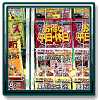![]() | Find us on Google+
| Find us on Google+
©2004 Marketing for Profits
Ltd - T/A MfP Website Marketing, Top Floor, 33 Southbourne Grove, Bournemouth, BH6 3QT,
UK.
Reg in England, number 3598244
![]() Tel: 01202-257423
Tel: 01202-257423 ![]() Fax:
01202-257423
Fax:
01202-257423 ![]() e-mail:
e-mail:
MfP
Website Marketing Services - based in Bournemouth, serving Poole & Christchurch, Dorset and Hampshire
10. Marketing & Sales Literature
| > marketing planning overview > |
| 1. overview | 2. planning | 3. swot | 4. marketing plan | 5. marketing mix | 6. product |
| 7. price | 8. promotion | 9. place | 10. literature | 11. public relations | 12. promos |
| 13. advertising | 14. sponsorship | 15. sales |
In my twenty years experience of marketing, one of the biggest problems I come across is the inappropriateness or mis-targeting of printed material.

Who reads your sales literature?
Do YOU read the direct mail, sales letters, and email that turn up on your desk? Probably not!
But occasionally you will come across an exception – apiece that captures your attention. A piece that will draw you to the sender's message, because the message is clear and genuine and creates a need for that product where a need may not previously have existed.
So, is your company producing the well read or the unread literature? Can you tell the difference?
Who writes your sales copy at the moment? Is it too technical?
Many companies will give the responsibility for writing the copy for sales
leaflets to the relevant product experts within their company. That makes
sense doesn't it? Not necessarily! The product specialist has
a technical bias and usually finds it very difficult, if not impossible to
pitch the communication at the right level.
One just needs to look at some of the companies selling computer hardware and
software to see examples of this.
Additionally, different customers will require the information to be pitched
differently, so you may well need 2 leaflets selling exactly the same product,
targeted at 2 quite different customer segments.
Who writes your copy at the moment? Is it targeted?
Another important issue to consider is ensuring your leaflet range has been organised and targeted correctly. Your internal product experts will probably produce literature based on your product range – i.e. one leaflet on product A, one leaflet on product B, etc. The marketing approach (or market-led approach) is more likely to recommend a range of leaflets based on customer groupings. Therefore, customer group X could be interested in products A and B, while customer group Y could be interested in products C and D. This approach is much more likely to generate additional business. It also lends itself much more effectively to mailing and telesales campaigns for example.
What we can do for you
We have an understanding of and access to a range of technical expertise and a long and successful history of sales and marketing campaigns. Together, these skills enable us to efficiently and effectively translate your selling argument from your product experts, making it relevant and attractive to the appropriate customer group.
Producing your Marketing Literature
Supporting product literature must present your company image very clearly and professionally. The detail and text are as important as the overall visual image that it projects.
When producing your literature it is vital to focus on the benefits of your product or service, and just produce a list of specifications to the reader, and not just list specifications and features. You need to be very clear about your focus before producing your literature.
- What is the purpose of this literature?
General company information; specific product details and benefits; specialist information?
- Who is the target readership of this literature?
You need to absolutely sure you have this right. It can be very easy to lose focus and end up with something vague like “working mothers between the ages of 34 and 42”. That is far too general, and if you miss the mark here, your literature is worthless.
- How do you get them to read it?
Actually, getting their attention is pretty easy – keeping it is the tricky bit. A clear message with a logical flow, and an understanding of your reader’s needs will keep them reading. If your research has been done correctly, you should be able to create a scenario that is familiar – and one that your product can improve. A clear explanation of its benefits should help create a desire for your product or service. Your readers need to relate your product to real-world situations, and this is where a well-written case study can prove invaluable.
- What is your budget for this literature?
This will help you focus on the level of quality you should expect from this literature?
- Who is the best person within your organisation to co-ordinate
this literature?
Marketing department, technical staff etc.
- Should you offer freebies?
Free stuff can be useful and of significant value. Either premium items or information, it should be both useful and consistent with your company's image and product or service. Be very sure that, as with your product line, your freebies are of good quality and give a favourable impression.
So, before you start putting together your sales literature think long and
hard about what you want it to do for you. Bad sales literature can
be worse than no sales literature. Do consider having your sales literature
professionally produced. We can work within most budgets, and understand
the financial constraints often faced by small businesses.
Please let us know what you are looking for; we are friendly and professional and would love to help. We can work with even the most basic ideas, and will help you work the smallest thoughts into targeted and meaningful sales literature.




